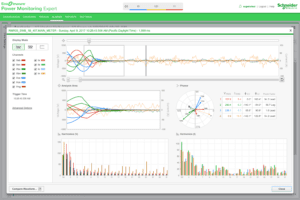If your industrial facility suffers a power outage, it will take down your electrical system as well as halting equipment operation and critical processes. Every minute of downtime, including retooling and restarting, can incur big losses for your business, both financially and in terms of reputation. In this post, we’ll look at how the newest power management tools for power analysis can help you isolate the source of an event quickly and restore power faster. (For more information about power management, read my blog series.)
Typically, when your facility loses power your team can determine the approximate time of the outage and the systems that were affected. However, you may not know what caused the outage, the precise sequence of events that lead to the outage, and which equipment in your electrical network worked as expected and which did not.
Causes of Power Outages and Power Analysis Solutions
The Electric Power Research Institute estimates that power quality problems cost up to $188 billion in losses annually in the U.S. alone. Multiple studies confirm that approximately 80 percent of power quality events originate within facilities, with only 20 percent coming from the utility side.
So, how can you pinpoint the source of a power disruption so steps can be taken to prevent them in the future? There can be a wide range of possible sources of power disruption, from human triggered events (e.g. operator error, transferring loads, exercising a generator, cybersecurity attack, etc.), to equipment malfunctions or failures (e.g. motors, circuit breakers, etc.), emergency power transfers, and power quality events.
With so many potential event sources, your team may waste precious time diagnosing the problem. Without the right tools, you may make incorrect guesses about what happened and, importantly, may be unable to prevent it from happening again. In some cases, a power event may be blamed on the electrical system design (i.e. the specifier), whereas the real source may be an installation problem (i.e. contractor error) or an operator error. You also need accurate equipment operation records to support insurance and warranty claims. If a facility outage is the result a power disturbance caused by your utility, you’ll want to be armed with concrete evidence to prove where fault lies.
This is where power analysis can help. Just like a forensic investigation, power analytic software tools enable you to work like a detective, using investigation methods to collect and analyze different sources of recorded data regarding an event to quickly uncover root causes. You can then go further to set action plans to avoid a recurrence. These tools help organize power forensic investigation in structured, meaningful ways, adhering to accepted industry standards.
Examples of Power Forensic Tools

Comprehensive power management software typically offers a variety of forensic tools, including:
- Ad-hoc alarm & event analysis. These tools may offer alarm prioritization and categorization, as well as filtering. Usability will depend on how well set up, tuned, and maintained the alarm system is.
- Timeline analysis. This user-friendly type of event interface can significantly speed up analysis by automatically pre-aggregating events that the analytic engine has identified as being related to the same incident. Events are visually arranged on a timeline, with the ability to drill down to more detail.
- Waveform analysis. Use these tools to analyze the wave shape and magnitude of events, as well as view coincident data such as harmonic calculations.
- Pre-calculated analytics. These can contain several powerful tools, including disturbance direction detection, whereby power quality meters determine if a disturbance occurred upstream or downstream of their location. Using this information, the power management software can help you isolate the event source quickly. Another tool is estimated load loss, which helps prioritize the incidents to investigate first.
Forensic Analysis in Practice
Let’s consider a short case study that illustrates the use of power analytic tools to isolate problems.
When you have a utility outage, your backup power sources like generators and UPS kick on. These will ensure life safety equipment – like elevators – continue to operate. But if transfer switches or breakers operate in an incorrect sequence, backup power will fail and critical equipment will be left offline.
In such a scenario, it is important to have an accurate audit trail, so you can pinpoint problems like stuck transfer switches or faulty generator controls. Where critical power is concerned, forensic tools are not nice-to-have, they are essential!
Specifying A Power Forensic Solution
Here are a few considerations when seeking a power management system that provides the appropriate forensic tools that your facility needs.
- IoT-enabled power quality devices with on-board data logging should be located on all critical electrical feeders in the facility.
- Smart devices should be used to monitor the status of all MV/LV switchgear and critical loads (e.g. motors, compressors, IT), onsite power generation, and UPS.
- Smart devices with millisecond-accurate timestamping and digital I/O to monitor the status of critical power distribution equipment (e.g. breaker status, ATS switch status, etc.)
Forensic tools for power event analysis are essential to modern facility operations. Analysis tools are easier to design and specify before the fact, rather than retrofit, so you should future-proof your power distribution with IoT-enabled devices and software tools. In terms of cost-benefit analysis, we have seen organizations fail to factor risk properly by not considering the cost of an outage and associated disruption in their ROI calculations. Once this is considered, the business case for power analysis tools becomes self-evident.
Learn how EcoStruxure Power can help
The EcoStruxure™ Power platform from Schneider Electric includes our award-winning EcoStruxure Power Monitoring Expert power management software, EcoStruxure Power Advisor services, and a wide range of PowerLogic smart power quality and energy metering devices. The IoT-enabled platform supports comprehensive power monitoring, analysis, and reporting, as well as tools to help optimize facility uptime, maintenance, and operational efficiency. To learn more, visit our Power and Energy Management Solutions page.



Conversation
Very informative article here. Thanks.